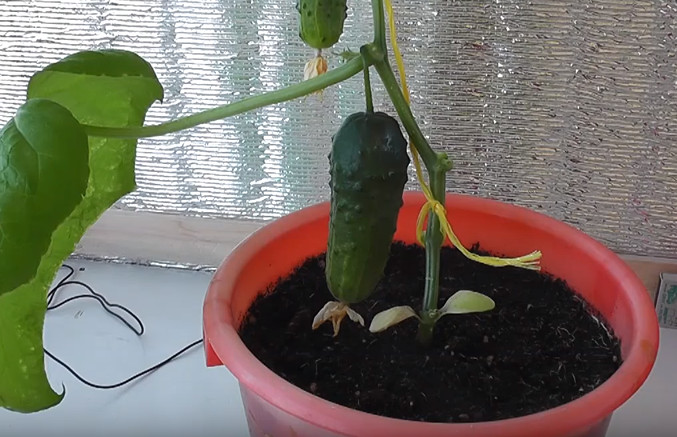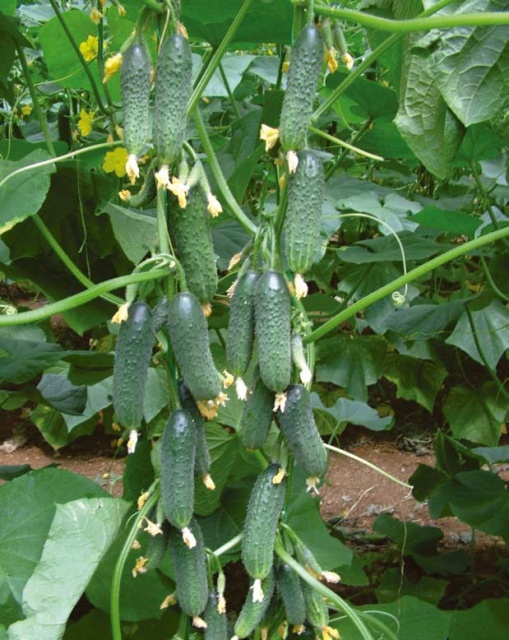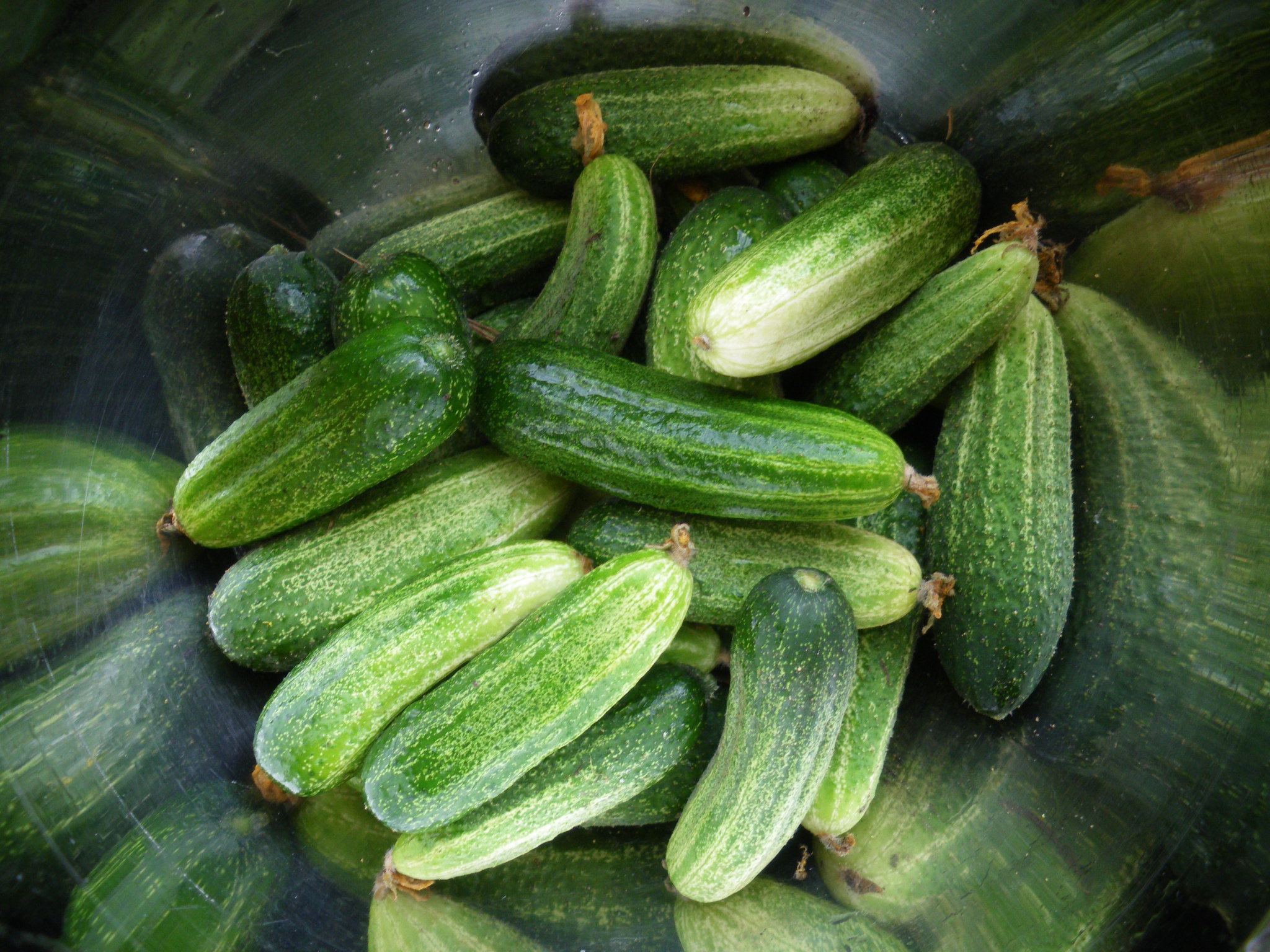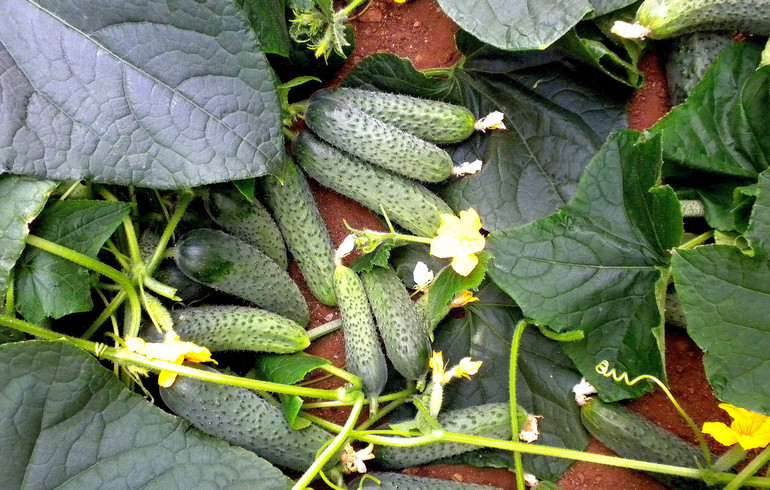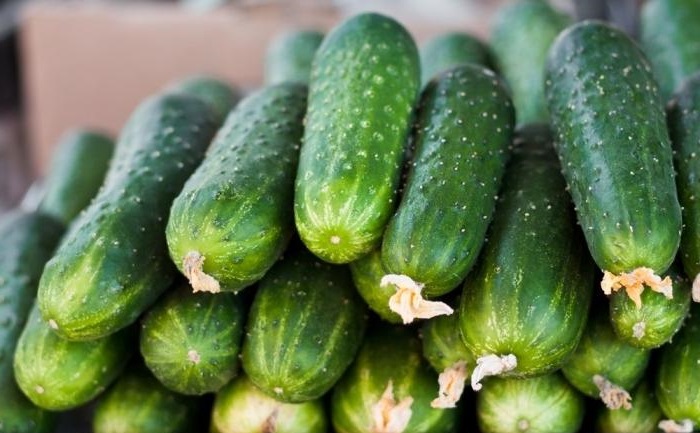Content:
For gardeners and vegetable growers, the creation of bunches of cucumbers by breeders turned out to be an expensive and desirable gift! Each inflorescence bears two to ten ovaries. Thus, the flower bouquet gradually turns into a cucumber bouquet.
Each lash brings a generous harvest of beautiful, neat, medium-sized cucumbers - gherkins and pickles.
In recent years, the varieties of bunch cucumbers have fallen in love with most lovers of home gardens for their sometimes unique qualities.
Beginners who have not yet experienced all the delights of bunched cucumbers, but who have heard about miracle fruits from neighbors, often ask the names of cucumbers that grow in bunches.
Features of the view
Among the fruits of the bundle species are found: parthenocarpic (fruit bearing without pollination) and pollinated by bees and other insects.
All varieties of the species are distinguished by high productivity, since the many formed ovaries guarantee abundant gradual ripening (flowers in a single inflorescence bloom at intervals of 1-2 days). In the lower part of the lash, ovaries are formed that are more modest in number, and abundant ones are formed in the center of the lash and above.
The fruits ripen all of approximately the same size and weight, which allows you not to worry about overgrown fruits. The multi-flowered ovary matures gradually - this is a good quality for urban gardeners who do not permanently live in the country. It is also a plus when harvesting fruits for the winter. Identical cucumbers are conveniently placed in containers for preservation.
Especially powerful bushes are capable of giving birth to up to 30 pieces! The rich harvest is 10 kg per bush.
Bunch varieties of cucumbers for soil and greenhouses
Landing (greenhouse) - early ripening, parthenocarpic, super-yielding, brings up to 17 kg per square meter. From the moment of planting in the greenhouse until the first fruit appears, it takes only 40 days. It is easily formed into a single stem, which greatly simplifies plant care. Its use in cooking is universal - it is great in salads, pickled and salted.
Son-in-law (both for greenhouses and for open ground) - early ripening, begins to bear fruit in 42-48 days from the moment of disembarkation. Yields a harvest from 1 square meter - 12-13 kg. Fruiting lasts all summer. Has immunity to fungal diseases. The fruits of the Zyatek variety are universal - they are good fresh, for canning and lightly salted.
Mother-in-law - (for greenhouses and open ground), parthenocarpic, early ripening. Has resistance to diseases, frost-resistant, universal use. The harvest is abundant, the ripening is gradual. Tesha cucumbers are used both fresh and for preparations for the winter.
All in a bunch - (open ground, greenhouse), parthenocarpic, medium early (before the first cucumber - 50 days from the day of planting). Resistant to typical cucumber diseases, fruitful throughout the summer. It is used fresh, canned. The taste is excellent.
Snowstorm - parthenocarpic, early maturation. Fruits appear 38 days after planting. Blizzard cucumbers, or rather cucumbers, are small in size, 6-8 cm each, usually 4 or 5 pieces are collected in a bouquet. Grows best in greenhouses. It is planted as seedlings.
The lash does not grow to a great height, it is easily formed into one trunk. Vyuga cucumbers have a great taste fresh and canned.
Seed preparation
Regardless of whether you decide to sow seeds at home for growing seedlings or sow immediately in a greenhouse or in open ground, the first thing to do is to prepare them. The only difference is in time. The seeds should be ready for growing seedlings already in late March - early April; you can wait another month to plant them in a greenhouse.
How to properly prepare seeds to increase their germination
- Pour all the seeds from the bag onto a clean sheet of paper and examine carefully. Use tweezers to choose the largest and evenest, light color. For more accurate calibration, place the selected specimens in a saline solution (a tablespoon of salt per liter of water) for 10-15 minutes. Poor-quality ones will emerge, they can be safely thrown away.
- An important procedure for the health of the future harvest is the disinfection of the planting material. To do this, use a solution of potassium permanganate of medium saturation (potassium permanganate crystals, about a third of a small spoon, per cup of water). In half an hour, the seeds will be sanitized, they should be rinsed with running water.
- Cucumber seeds also respond well to treatment with Fitosporin-M and Baksis. They are soaked for a couple of hours in a solution of one of the drugs. Dry after the procedure.
- Warming up the seeds before sowing. Two modes are possible: three days at a temperature of 40 degrees or one - at a temperature of 80 degrees C. Someone has adapted to the oven, someone - to the surface above the heating battery.
- Seed soaking (attention! The method is effective only for further growing seedlings). They are placed in a plate or saucer, the bottom of which is covered with a cloth folded in several layers (you can use gauze), water is poured on top, but so that the seeds do not float in the water. After a few days at room temperature, the shell of the seeds will begin to burst, and then tiny sprouts will hatch.
- The required procedure is hardening. She will prepare the future plant for temperature extremes. The hatched seeds are left in the refrigerator for several days, wrapped in a damp cloth. In no case should it dry out!
Now is the time to plant the seeds in the seedling container.
Sowing seeds in a greenhouse
The main condition for obtaining a harvest of cucumbers is fertile soil: loose, moist, nutritious, with neutral acidity. It is best to prepare the soil in autumn or early spring. A bucket of compost or humus is added to 1 square meter.
The most effective is the combined use of fertilizers - mineral and organic. 30 gr. nitrogen, 40 gr. phosphoric, 20 gr. potash per 1 square meter. If you do not want to use mineral fertilizers, manure and a glass of ash (per 1 square meter) are introduced for digging.
3-4 seeds are sown in each hole, after emergence the strongest is left. Sowing depth - no more than 2 cm. 4 or 5 plants should fit on one square meter. Water well and cover the sowing with a film - this way moisture and heat are retained. As soon as the first shoots appear, the film must be removed.
Planting seedlings in a greenhouse
The soil for seedlings is prepared in the same way as for sowing.
Seedlings are planted in the evening or in cloudy weather. Pour mute water (up to 30 degrees) into the hole, pour garden soil into the water, plant a seedling bush in a peat pot in the resulting mixture. Cover with earth, slightly deepening the trunk of the bush. Water the planting abundantly with warm water from a watering can. After absorbing moisture, be sure to loosen the earth, very carefully, without damaging the roots.
Planting seeds in open ground
Landing rules:
- Correct organization of the garden - a sunny place is chosen for it, on which any pumpkin plants were not grown last season.
- The bed is made no more than 70 cm wide, otherwise it will not be easy to process.
- The earth is dug to the depth of the shovel bayonet. First, organic matter is applied (about 5 kg per square meter), then - complex mineral fertilizer.
- After that, the soil is leveled and a longitudinal groove is made with a depth of 2 cm.
- A growth stimulator solution is poured into the groove abundantly.
- Sow seeds at a distance of half a meter from each other. Lightly press each seed with your finger to the ground and cover with moist fertile soil. No other watering is required yet.
- To avoid the destruction of seeds by ants and other insects, powder the sowing with ground pepper, and then cover the bed with a covering material.
- After the cucumbers have sprout, remove the cover from the garden and raise it to the previously prepared arcs. Their height should be about one and a half meters. In the future, it will be convenient to tie lashes to them.
- Prestige - high yields, bears fruit all summer, up to frost, calmly refers to temperature changes;
- Ginga - the yield is average, but it is immune to fungal diseases;
- Okhotny Ryad - bears fruit all season, but requires the prevention of fungal diseases;
- Beam splendor - high yield and good adaptation to the conditions of the northern regions of Russia, practically does not become infected with fungus.
In addition, the Blizzard cucumber is also suitable for growing in vegetable garden beds. Cucumber All bunch and varieties Zyatek, Champion, Siberian garland also worked well in the open field.
Growing at home
Bundle cucumbers can be grown at home on the windowsill. Varieties have been developed that will tolerate much more shade than those that grow in a greenhouse. Another distinctive feature of the home garden is the absence of temperature drops, day and night. But you can easily pollinate varieties that need it, it is not at all necessary to plant a parthenocarpic bundle cucumber.
The home gardener has a large selection of varieties, you can grow:
- Forward - with weak branching;
- Faust- medium branching;
- Prima donna and Patti - bundle ovary;
- Relay race - will require manual pollination.
Benefits of growing on trellises
For the convenience of growing, many people use a trellis - a support for the climbing stems of a plant. This simple device is convenient in any conditions - in a greenhouse, outdoors, indoors, on a balcony. Cucumber stalks stretch upwards along it, towards the light, do not intertwine with the stems of neighboring plants.
It has been proven in practice that:
- trellis growing increases vegetation and productivity;
- leaves are well ventilated, do not suffer from fungal diseases;
- the fruits remain clean, they are not affected by rot;
- the harvesting process is simplified;
- outdoors, a trellis entwined with cucumbers decorates the site.
Making a device with your own hands is not so difficult. It can be wooden, metal, using improvised means, for example, old bicycle wheels will be used.
Heat resistance and frost resistance
The cucumber is not very heat resistant.In hot and arid regions, preference should be given to well-branching plants of the following varieties: First class, Grasshopper, Ant, Farmer, Petrel.
Frost resistance depends on the content of trace elements in the soil. Therefore, one should not neglect mineral fertilizers when preparing the land for planting, as well as during the growing season. It is useful, especially before sowing in open ground, to soak the seeds in a weak solution of trace elements.
Disease resistance of the species
Clustered cucumbers, being a hybrid, have good disease resistance. With proper preparation of seeds and soil, as well as with good care of growing fruits, it is possible to avoid typical diseases. However, you cannot ignore the basic rules for caring for cucumbers, even hybrid ones.
- Disinfection of seeds.
- Compliance with crop rotation.
- Application of mineral fertilizers.
- Preventive treatment of soil and plants with chemicals or folk remedies.
- Weed control.
- Thinning (removal of excess processes and ovaries).
- Adequate, but not excessive watering.
These measures will help you grow a healthy and bountiful harvest.
Fruiting
Almost all varieties are distinguished by high yields, and the fruiting period lasts the entire season. But it happens that the number of ovaries decreases. Some reasons for this:
- drying out of the soil (increase watering);
- excess nitrogen in the soil (reduce nitrogen fertilization);
- very high temperature or vice versa lack of sunlight. The optimal soil temperature is 23-24 degrees, the culture is planted in sunny areas, placement on trellises is of great help;
- drafts;
- late collection of fruits. Harvesting should be done daily, avoiding overgrown cucumbers.
Disease resistance
Hybrids are highly resistant to disease and are rarely affected by them, but there are exceptions.
The most common cucumber diseases and methods of dealing with them:
- Powdery mildew - correct crop rotation, disinfection of soil and seeds, watering with warm water. When the first signs appear - treatment of plants with Topaz;
- Downy mildew - watering with warm water, airing, regular collection of fruits. At the first signs - treatment of plants with Bordeaux liquid;
- Cladosporium - ventilation, weeding, removal of plant residues, warm watering, observance of crop rotation. With signs of illness: treatment with Bordeaux liquid, cessation of watering for several days;
- Sclerotinia - ventilation, compliance with crop rotation. At the first sign - feeding with urea, copper sulfate and zinc.
- Gray rot - ventilation, correct crop rotation, removal of plant residues. At the first sign: remove diseased leaves and fruits, process special. A preparation against gray rot - "Bayleton";
- Root rot - compliance with the irrigation regime, correct crop rotation, watering with warm water. With signs: adding new soil around the roots, cutting the basal leaves - this promotes the formation of new roots.
- Anthracnose- correct crop rotation, keeping the soil clean (no plant residues). With signs: treatment with Bordeaux liquid and copper sulfate solution.
Bunch cucumbers yield many times more yield (in the greenhouse and in the open field), the size and appearance are enviably different from representatives of other varieties. High resistance to fungal diseases and unpretentious care are advantages that can hardly be overestimated.





